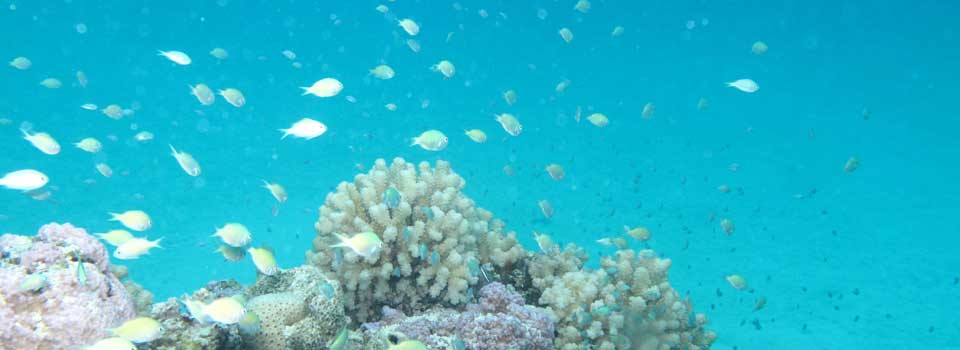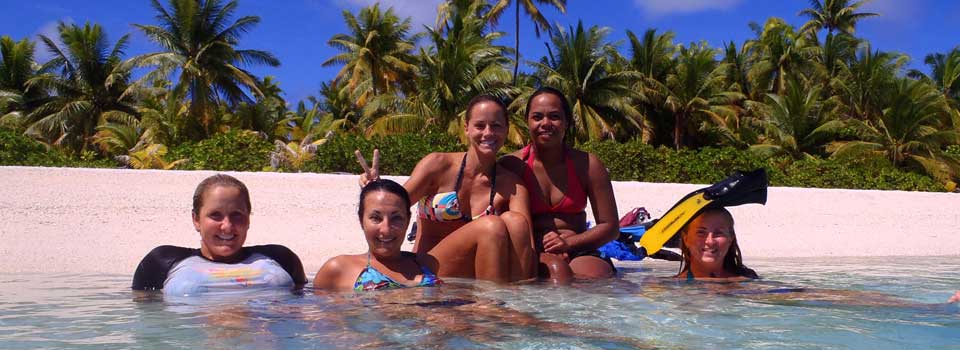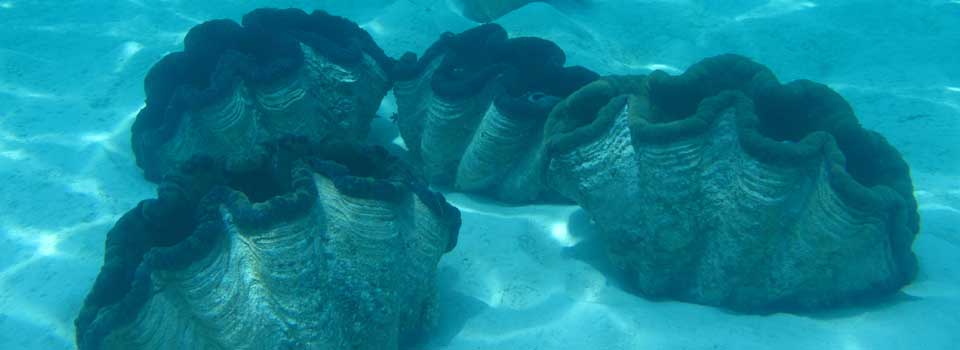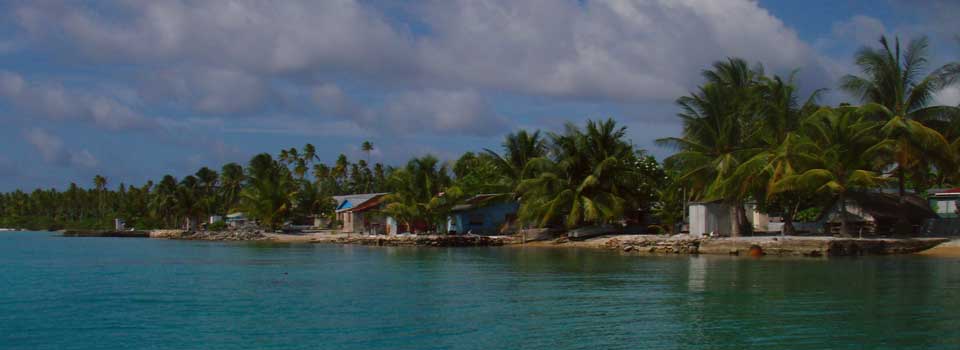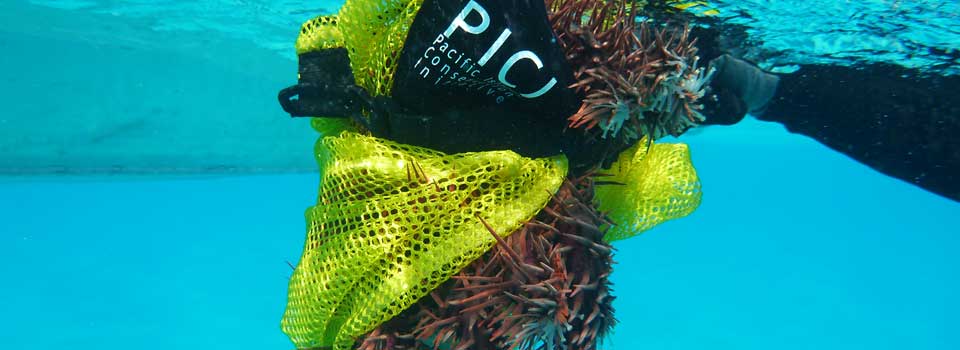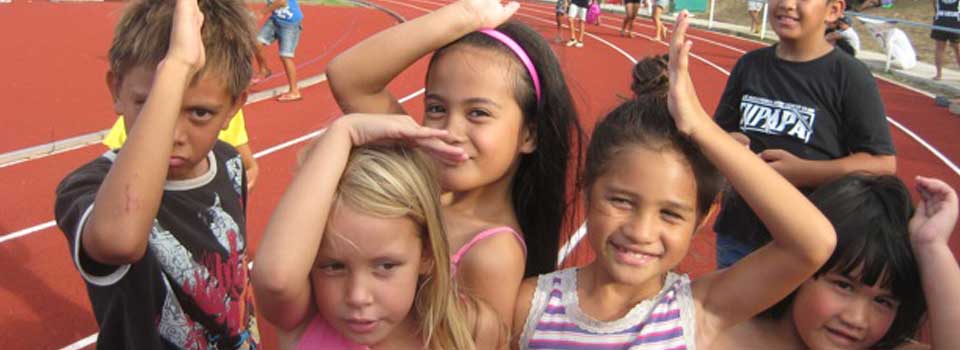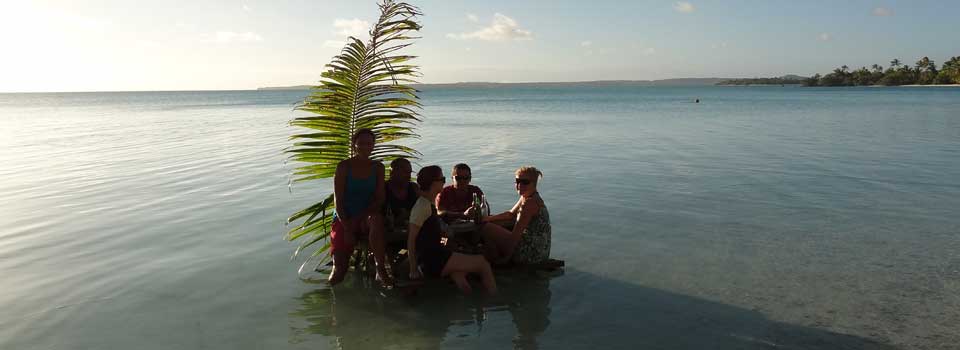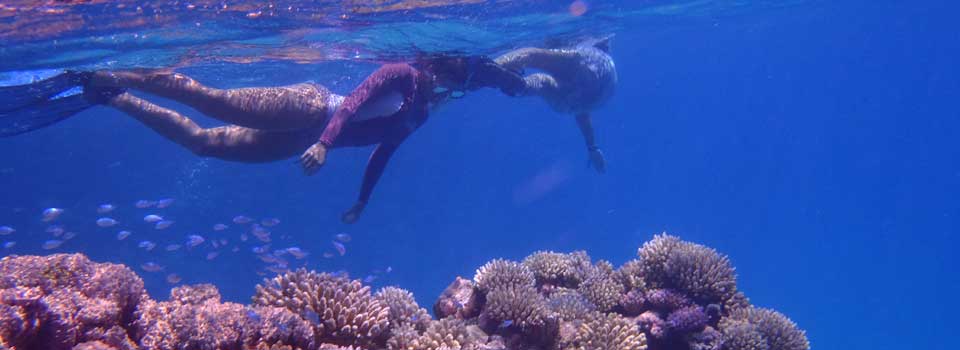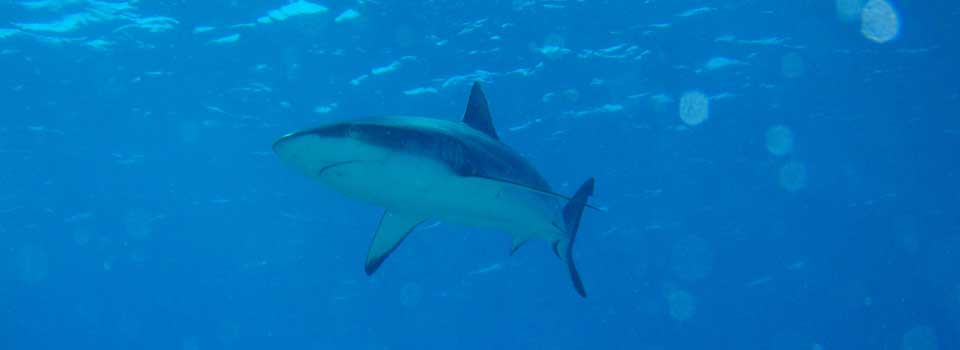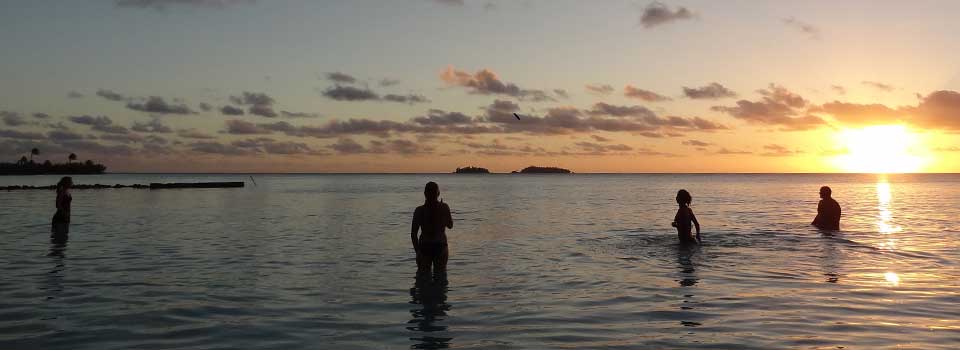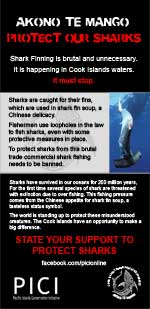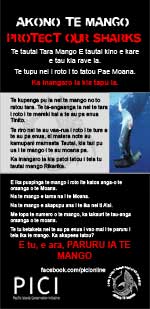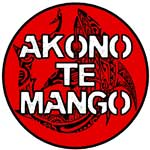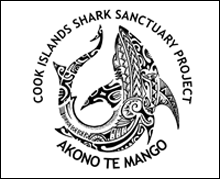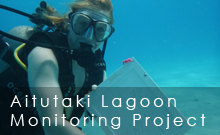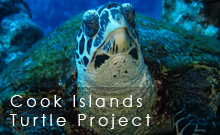The Shark Sanctuary Campaign
This page is to give those interested the background of our campaign and access to some of the collateral we produced.
I had the idea of protecting sharks in the Cook Islands about 6 years ago, inspired by the whale sanctuary in our waters. However I am a bit of an ideas man and didn't have the time to see this through immediately. In May 2011, Jess Cramp joined PICI as our first programme manager with an immediate affect on the organisation. Jess crystalized my visions and part of that was driving the Cook Islands Shark Sancutary Project forward. - Stephen Lyon, Founder PICI
From the outset we reached out to the international community for support, but found it very hard to obtain. Wanting to get the project moving, we decided to develop a campaign that used local resources and reached out to the community. With the help from local business sponsors, we produced our first set of media, like these posters, to raise awareness of the issue.
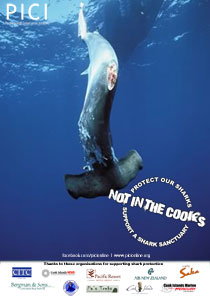 |
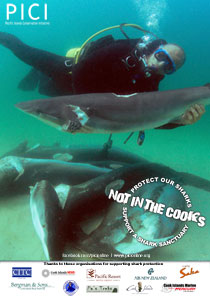 |
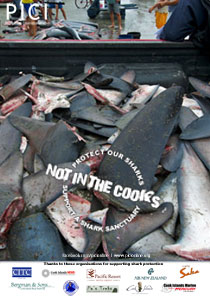 |
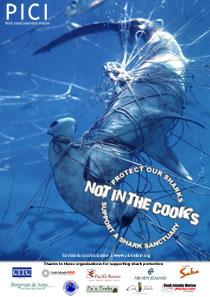 |
We did our own analysis of the current National Plan Of Action (NPOA) for sharks as well as the Marine Resources Act (2005) (MRA), [LONGLINE ORDER] the governing legislation for fishing. We found that while the act promoted the sustainable management of resources, sharks didn't have any regulations to stop commercial exploitation. The NPOA highlighted the issue, but was powerless to affect management through a lack of enforcement capability.
It was our initial intention to protect sharks through an independent Act, however regulations under the MRA would be more in-line with current fisheries management and enforcement, which was the preferred approach by those within the Marine Resources Ministry. The Act allows for Regulations to be established with regards to any fishery, so this is the pathway we chose to establish the shark sanctuary.
In late 2011, Jess did some amazing media outreach, using images and support we had already established to publicize our campaign internationally. This received coverage in serveral large newspapers including the New Zealand Herald and LA Times. From those articles came offers of support, and this was a turning point in the campaign. One of the best finds was Michael Balster, an Environmental Attorney with Paul Hastings LLP.
View the New Zealand Herald article here.
View the LA Times article here.
Michael has been instrumental in the drafting of the regulations, taking our intent and producing regulations in the format required by Cook Islands law. Michael was required to redraft these regulations countless times, including a complete format change that came into effect for all regulations midway through the campaign. Michael, through the generosity of Paul Hastings LLP, did this work pro bono, and with the greatest efficiency. He far exceeded our expecations in both professionalism and ability.
Another great outcome was the interest of the PEW Global Shark Campaign.We had been in contact with PEW earlier in the campaign, but the international exposure helped then Director Matt Rand to send someone out to see if we were worth working with. Stefanie Bredl spent 2 weeks in Rarotonga, and the result was a relationship with PEW that would see PEW partially support the campaign, giving us the ability to produce more collateral and visit the remote outer islands communities. Their support also enabled Jess to remain with the campaign for longer than initially anticipated.
The initial assessment of the pathway to establishing a shark sanctuary seemed much simpler than it turned out to be. Our naivity in fisheries management showed through. There were several times we thought we were close only to feel an invisible wall press back against us. In April, Jess went on a month long turtle expedition and was nervous the declaration might be made in her absence. It took 7 more months.
We decided we needed an icon to help give recognition to the campaign, so we had local tattoo artist Tama Garnier design a symbol. If you look carefully at the symbol it includes a hidden Manta Ray, with the dorsal and outer pectoral fin making up it's wings. As Tama is of Cook Islands and Tahitian descent, the iconography inlcudes styles of both the Cook Islands and French Polynesia. Click for a larger image. Note the icon was flipped and rotated for our eventual design.
Our initial optimism came from the Prime Minister's statement of creating what at the time was the world's largest marine park. We thought this kind of political will would surely support shark protection, given there is no benefit in the Cook Islands from shark fishing and several communities and organisations were supporting us. However, while the Prime Minister's intentions were good, the shark issue sat squarely with the Ministry of Marine Resources, the Secretary of which, has been our biggest opposition.
Some of the print collateral produced included flyers in English and Cook Islands Maori, and stickers. They were widely dispersed to help educate the public on what the protection of sharks means for the Cook Islands.
You can see one of the PSAs produced using local ambassadors here. This video really worked well to introduce the topic and get people thinking openly about the issue.
And here's another of Matiu John talking about sharks! Matiu video
In order to gain the political will, we needed to get the voice of the people heard. We continued on a well publicized campaign, visiting as many islands and communities as possible, and writing to those we could not physically get to. We also engaged all the community organisations that have an interest, including other environmental NGOs, fishing associations and so on. We gained the support of Cook Islands-owned fishing companies, who do not have an interest in shark fishing or finning, and interviewed the Captain of one vessel, who gave us great insight into the world of the illicit shark fin trade and how it operated.
We also engaged with as many schools as possible. The voice of the child is very powerful when it falls on the ears of parents. School kids drew posters, wrote letters and showed their support in joyous and colourful fashion.
Many prominent Cook Islanders came on-board in support of shark protection. These include local legends, Pa Teuruaa, Danny Mataroa and Tua Pittman, Miss Cook Islands Teuira Napa, Kate Ngatokorua (2nd in Miss South Pacific 2012) , traditional voyager Alex Olah and others from the Marumaru Atua Cook Islands Vaka. These people circulated a petition, spoke at public events, featured in our public service announcements, and engaged many individuals and the local schools.
Throughout the public campaign, we continued to work with staff of the Minstry of Marine Resources to ensure the regulations were in-line with what the Ministry would establish if it were to protect sharks. We also engaged with each Minister and the Leader of the Opposition, to keep them informed of our intent and progress of the campaign. Every person and organisation we met with in the community were supportive.
Good fortune allowed the Cook Islands host the Pacifc Islands Forum in 2012, a meeting of all regional leaders, at which we had a booth for our organisation. Madame Secretary Hillary Clinton, the US Secretary of State was in attendance, the most important person to visit the Cook Islands in many years. During the forum we met with many people from nations that had already protected sharks, and were overwhelmed with their support. We heard no negative outcomes. These people reached out to our own politicians, and brought a different perspective to the argument. At this stage we were getting the feeling the political will was there to protect sharks, the Prime Minister had said enough times that he didn't see a problem with it. However, we still struggled to get any real traction where it mattered.
We produced a wrap with the assistance of PEW during the Forum. This was published on a key day of the forum and generated a huge amount of regional support. Click the images for readable versions.
 |
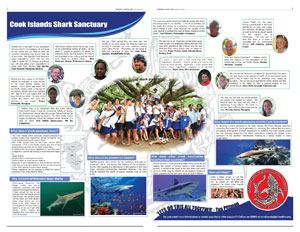 |
In a bid to control the issue, the Secretary of Marine Resources brought in a very respected fisheries scientist, Dr.Shelly Clarke, to assist in redrafting the NPOA - Sharks. Consultations were held, and while the vast majority agreed that no shark fishing was the simpilest way to manage sharks, the Ministry pressed on and produced a revised draft NPOA that still allowed for most species to be retained, and equipment used to target sharks allowed. However the clearest failure of the NPOA was the still missing ability to properly punish those in breach of it. Rather than having clear enforcement guidelines, infringements against the NPOA were to be referred to the Secretary. This NPOA actually moved to establish a quasi shark fishery in the Cook Islands. We submitted a detailed proposal for highlighting what we felt was missing from this new draft NPOA.
During the following months we kept up with the public campaign, visiting communities and schools, and informing decision makers about our progress. Trips to the outer islands of the Cook Islands were extremely welcomed by the communities, and we found these consultations particularly interesting as these people fish on the sea for their food every day. We also had to opportunity to experience some of the more remote places in the Pacific, swim in limestone caves, explore seldom visited places and meet the most generous and kind people.
The petitions continued to gain numbers and more people started to ask why the sanctuary had not been declared.
Continued campaigning and some clear arguments put forward to the Minister of Marine Resources saw a turning point late in Octoboer, when the Minister saw the benefit of protection of sharks over any by-catch related fishery. In his wisdom he saw the benefit not only to sharks, but also to the Cook Islands, through the leverage and interest generated in the destination. He also saw the potential for locally caught and produced Cook Islands Golden Tuna to become the worlds first Tuna brand to be labelled 'Shark friendly'.
With the support of the Minister of Marine Resources, Hon Teina Bishop, the campaign has concluded on a very positive note, with the whole nation supporting the protection of sharks.
Open the photo gallery for the campaign. This will be updated as we sort through images. Photo Gallery.
See a collection of local articles published in Cook Islands News relevant to the campaign.
If you have any questions you can email either Stephen.
Page written and updated by Stephen Lyon, 14 December 2012
Current time in the Cook Islands is

